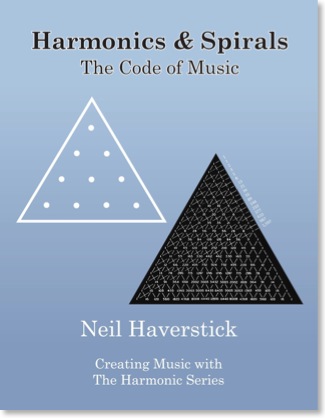Harmonics & Spirals - a review
14 August 2017 Filed in: Tuning
Theory

A book by Neil Haverstick
HOW TO ORDER THE BOOK
DOWNLOAD THIS REVIEW
Why write still another book about tuning systems?
Are there not many around already?
Neil Haverstick is primarily a guitar player that, being a curious soul, has delved into alternative tunings for a long time and that made him a theoretician too.
When you write a book about tuning systems there are two possible options: you either write a huge tome like Cris Forster did with his "Musical Mathematics" or you try to simplify this complicated matter risking to sound shallow and incomplete.
Neil's intent is to address this convoluted matter in simple terms, a difficult task.
His strategy is to limit this book "only" to what can be done with the harmonic series and the circle (or spiral) of fifths. These elements are the oldest means known to men to create scales, melodies and consequently music and still the base nowadays for much of Eastern music.
Neil states that being aware of these building blocks of music "make us more complete as musicians" instead of taking for granted the one and only tuning system we use in the West, 12 tone equal temperament. I could not agree more!
The harmonic series is not an invention of humans ("it is part of the universal structure" he says) and I find this sentence, as obvious as it is, brilliant and a good reason to investigate it.
"Math folks" probably would find this book lacking indispensable details but they have plenty of other resources to quench their thirst for precision and personally, being mathematically challenged, I was able to understand everything Neil wrote and appreciate it.
He states throughout the book, over and over, that "the spaces between the notes in the harmonic series are not the same as in 12 tone equal temperament" even though they share the same names. Clearly this is a book for someone who does not know much about this matter and want to be gently introduced to it.
That is why he only slightly mentions things like inharmonic partials or non octave scales.
A potentially confusing matter that probably deserved to be better explained is that the third harmonic becomes the fifth grade of a scale and the fifth harmonic becomes the third grade of a (major) scale.
He moves from one octave to the following ones to analyze which harmonics they contain (up to the 32nd) and here I think a better explanation of the "octave reduction" process needed to bring all the values within the span of one octave was necessary. That is only explained later in the book.
He introduces cents to measure intervals even though "ratios are the true and real way that intervals occur in nature". The translation from ratios to cents is not clear but interested people can dig as much as they want elsewhere. By the way all values in cents are rounded off "for simplicity's sake".
Neil explains why in the West, theorists, musicians and instruments builders, agreed, after many centuries of debate, to use a equally tempered scale in order to build "chords from scales…and to modulate these chords to different keys" while in the East, music remains mostly modal without needing any tempering of the intervals found in the harmonic series.
Is it possible to solve this problem with musical instruments having more than 12 frets or keys per octave? The easiest way to do it is using electronic instruments but solutions for acoustic instrument are available too even though they are not mainstream yet.
The second part of the book deals with the spiral of fifths and, of course, with the concept of "prime limits". He explains why it is a spiral and not a circle and deals with the infamous Pythagorean comma. He further goes from ascending to descending spirals and explains why the two spirals creates different intervals and how to combine intervals of both to create "3 limit" scales.
Then he tells us what happened later in the history of tuning systems with the introduction of meantone and well temperaments splitting the syntonic comma in different ways to get circulating systems that in the end brought to the equal temperament in use nowadays.
Part three of the book goes back to "using the harmonic series in music" explaining how "an interval is an AREA, a space where several different sizes of the same pitch can occur, depending on how they are arrived at" and how minute differences in pitch can completely change the character of an interval and consequently the mood of the scale that it is part of. Unfortunately all these subtleties are lost with the standardization of equal temperaments.
But there is no need to despair because experiments are carried out all over the world and Neil himself is a stalwart practitioner explaining the tuning he has used for some of his tunes.
Part four gives a taste of the work of Ervin Wilson, a "legendary tuning theorist" showing some of his diagrams he sent personally to Neil. Some are comprehensible, some are not (but that is me).
The book ends with a nice bibliography and with a paper by John Starrett that is very useful to better understand what Neil wrote. As usual, to really understand a manual like this one you have to read it twice or be helped by someone guiding you.
I would say this is a nice introduction to this very complex subject. Highly recommendable.
There are a few typos not mentioned in the "corrections" that could be corrected in the next edition.
Thanks for mentioning me among "a few names well worth checking out"!


